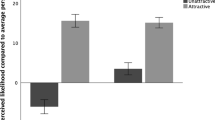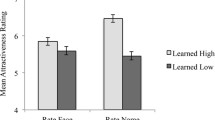Abstract
This research investigated two related questions. First, do stereotyped attribute judgments emerge based on attractiveness information presented under severely restricted viewing conditions? Second, will similar biased judgments be obtained for the same targets when subjects are permitted unrestricted viewing time? Experiment 1 found that male and female Caucasian college students were able to differentiate between levels of attractiveness of both males and females on the basis of cue information contained in a single brief glance (100 ms) at a target. Subjects made stereotyped attribute judgments of targets' femininity/masculinity, job suitability, and cooperativeness based on this information under restricted and unrestricted (Experiment 2) conditions. Subjects' eye fixation patterns, recorded during the second experiment, revealed that men and women differed in the way they explored targets, but their differing search strategies had no significant effect on physical attractiveness stereotyping. Results suggest that perception of differential attractiveness occurs automatically with the initial encoding of sensory data.
Similar content being viewed by others
References
Beehr, T., & Gilmore, D. (1982). Applicant attractiveness as a perceived job-related variable in selection of management trainees. Academy of Management Journal, 25, 607–617.
Bull, R., & Rumsey, N. (1988). The social psychology of facial appearance. New York: Springer-Verlag.
Deaux, K., & Lewis, L. (1984). The structure of gender and stereotypes: Interrelationship among components and gender labels. Journal of Personality and Social Psychology, 46, 991–1004.
Calis, G., & Mens, L. (1986). Primary stages in single-glance face recognition: Expression and identity. In H. Ellis, M. Jeeves, F. Newcombe, & A. Young (Eds.), Aspects of face processing. Dordrecht: Martinus Nijhoff Publishers.
Cash, T. F. (1990). The psychology of physical appearance: Aesthetics, attributes, and images. In T. Cash & T. Pruzinsky (Eds.), Body images: Development, deviance and change. New York: Guilford Press.
Cash, T. F., & Pruzinsky, T. (1990). Body images: Development, deviance and change. New York: Guilford Press.
Dion, K., Berscheid, E., & Walster, E. (1972). What is beautiful is good. Journal of Personality and Social Psychology, 24, 285–290.
Eagly, A., Ashmore, R., Makhijani, M., & Longo, L. (1991). A meta-analytic review of research on the physical attractiveness stereotype. Psychological Bulletin, 110, 109–128.
Fraser, I., Craig, G., & Parker, D. (1990). Reaction time measures of feature saliency in schematic faces. Perception, 19, 661–673.
Gillen, B. (1981). Physical attractiveness: A determinant of two types of goodness. Personality and Social Psychology Bulletin, 7, 277–281.
Hadiks, D., & Locher, P. (1985, March). Effects of interpretive set and viewer's sex on fixation patterns during the encoding of ongoing behavior. Paper presented at the annual meeting of the Eastern Psychological Association, Boston.
Hall, J. (1978). Gender effects in decoding nonverbal cues. Psychological Bulletin, 85, 845–857.
Hatfield, E., & Sprecher, S. (1986). Mirror, mirror: The importance of looks in everyday life. Albany: State University of New York.
Heilman, M., & Saruwatri, L. (1979). When beauty is beastly: The effects of appearance and sex on evaluations of job applicants for managerial and nonmanagerial jobs. Organizational Behavior and Human Performance, 23, 360–372.
Hill, T., Lewicki, P., Czyzewska, M., & Schuller, G. (1990). The role of learned inferential encoding rules in the perception of faces: Effects of nonconscious self-perpetuation of bias. Journal of Experimental Social Psychology, 26, 350–371.
LeMay, M., & Unger, R. (1982, April), The perception of females and males: The relationship between physical attractiveness and gender. Paper presented at the annual meeting of the Eastern Psychological Association, Baltimore, MD.
Locher, P., & Worms, P. (1977). Visual scanning strategies of neurologically impaired and normal children viewing the Bender Gestalt Test. Psychology in the Schools, 14, 147–157.
Major, B., & Deaux, K. (1981). Physical attractiveness and masculinity and femininity. Personality and Social Psychology Bulletin, 7, 24–28.
Rayner, K. (1983). Eye movements in reading: Perceptual and language processes. New York: Academic Press.
Spence, J., & Sawin, L. (1985). Images of masculinity and femininity. In V. O'Leary, R. Unger, & B. Eallston (Eds.), Women, gender, and social psychology. Hillsdale, NJ: Erlbaum.
Unger, R. K. (1979). Toward a redefinition of sex and gender. American Psychologist, 34, 1085–1094.
Unger, R., & Crawford, M. (1992). Women and gender: A feminist psychology. Philadelphia, PA: Temple University Press.
Wallston, B., & O'Leary, V. (1981). Sex makes a difference: Differential perceptions of women and men. In L. Wheeler (Ed.), Review of personality and social psychology. Beverly Hills, CA: Sage.
Author information
Authors and Affiliations
Additional information
This article is based on master's theses completed by the third and fourth authors under the first and second authors' supervision.
Rights and permissions
About this article
Cite this article
Locher, P., Unger, R., Sociedade, P. et al. At first glance: Accessibility of the physical attractiveness stereotype. Sex Roles 28, 729–743 (1993). https://doi.org/10.1007/BF00289990
Issue Date:
DOI: https://doi.org/10.1007/BF00289990




